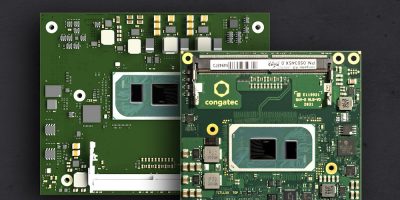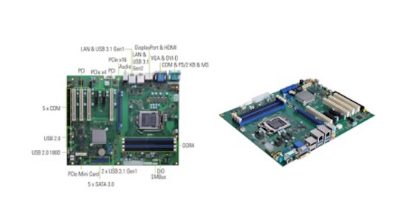Embedded and edge computing company, congatec has introduced 12 computer on modules based on Intel’s new 11th Gen Intel Core processors. The modules are based on the low power, high density Tiger Lake SoCs and are claimed to deliver “significantly greater” CPU performance and nearly three times higher GPU performance, together with PCIe Gen4 and USB4 support. The congatec COM-HPC and COM Express Computer on Modules will accelerate fanless edge applications in harsh industrial and embedded environments, such as industrial and tactile IoT, machine vision and situational awareness, real-time control and collaborative robotics. They also apply to real-time edge analytics and artificial intelligence (AI) with inference workloads enabled to run across all four new CPU cores, or on up to 96 graphics execution units of the new Intel Iris Xe graphics.
The performance delivered by the Intel Iris Xe graphics has nearly tripled compared to predecessor modules based on 8th Gen Intel Core processor technology. This opens up opportunities in the graphics intensive medical imaging and immersive digital signage sectors. They can also be used in the industrial machine vision and AI-based public safety sectors where capturing and analysing several video streams in real-time is critical for object recognition.
“For . . . applications like collaborative robotics, autonomous vehicles, AI, or contactless retail markets, congatec’s 11th Gen Intel Core processor-based modules take advantage of the ‘total compute’ capabilities of the CPU and GPU,” said Jonathan Luse, senior director of Intel’s Industrial Solutions Division. “In combination with Intel Time Coordinated Computing technologies, extensive virtualisation and in-band error correction, these new platforms help minimise jitter . . . to meet the demands of critical real-time computing applications,” he continued.
The modules complementing the COM-HPC and COM Express Computer-on-Modules that congatec announced at the introduction of the SoCs. There are Intel Core i7, i5 and i3 variants for both the COM-HPC Size A and COM Express Compact Type 6 Computer-on-Modules.
According to congatec, design engineers now have the choice to go either with COM Express or COM-HPC. To help engineers make the best choice, congatec provides engineering support and is creating a COM Express vs COM-HPC design decision guide. This is available for download on the product pages of the conga‑HPC/cTLU COM-HPC Client module and the conga-TC570 COM Express Compact module.
The conga-HPC/cTLU COM-HPC Client Size A module and conga-TC570 COM Express Compact module will become available with new scalable 11th Gen Intel Core processors. Both modules are the first to support PCIe x4 in Gen 4 performance to connect peripherals with massive bandwidth. In addition, designers can leverage eight PCIe Gen 3.0 x1 lanes.
Where the COM-HPC module offers two USB 4.0, two USB 3.2 Gen 2, and eight USB 2.0, the COM Express module offers four USB 3.2 Gen 2 and eight USB 2.0 in compliance to the PICMG specification. COM-HPC modules offer two 2.5 GbE for networking, whereas COM Express modules execute one GbE, with both supporting TSN. Sound is provided via I2S and SoundWire in the COM-HPC version and HDA in the COM Express modules.
Congatec offers board support packages for all leading RTOS’s, including hypervisor support from Real-Time Systems as well as Linux, Windows and Chrome.







